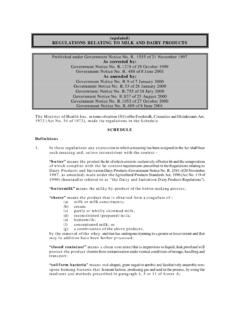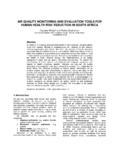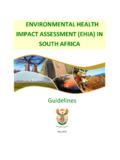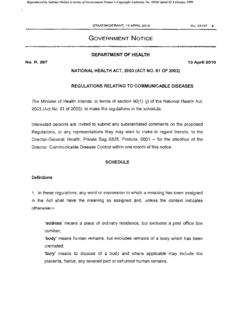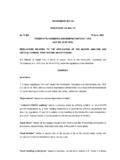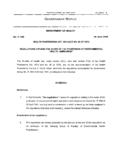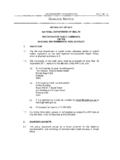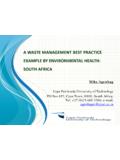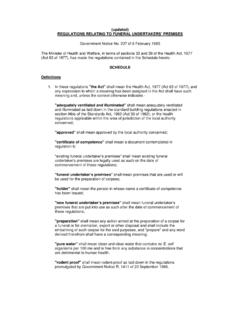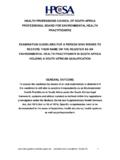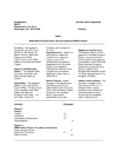Transcription of No. R. 8 February 2008 - EHRN - Environmental Health ...
1 14 No. 30722 GOVERNMENT GAZETTE, 8 February 2008 No. R. 123 8 February 2008 Health PROFESSIONS ACT, 1974 (ACT NO. 56 OF 1974 REGULATIONS DEFINING THE SCOPE OF THE PROFESSION OF Environmental Health : AMENDMENT The Minister of Health intends, under Section 33(1) read with Section 61(2) of the Health Professions Act, 1974 (Act No. 56 of 1974) and on the recommendation of the Council, to make the amendments to the regulations as published under Government Notice No. of 26 April 1991 as reflected in the Schedule. Interested persons are invited to submit any substantiated comments or representations in writing on the propos-ed amendments to the regulations to the Director-General: Health , Private Bag X828, Pretoria, 0001 (for the attention of the Director: Human Resources Stakeholders Relations and Management Services) within three months from the date of publication of this Notice.)
2 SCHEDULE Definitions 1. In this Schedule, "the regulations" means the regulations defining the Scope of the Profession of Environmental Health published under Government Notice No. of 25 April 1991, and any word or expression to which a meaning has been assigned in the regulations shall bear such meaning, unless the context otherwise indicates. Amendment of the regulations 2. The regulations are hereby amended by the addition at the end of the regulations as an Annexure, of the following Scope of Practice for Environmental Health Practitioners. STAATSKOERANT, 8 FEBRUARIE 2008 No. 30722 15 ANNEXURE SCOPE OF PRACTICE OF Environmental Health PRACTITIONERS In addition to the scope of the profession as prescribed in the regulations, the following acts fall within the Scope of Practice for Environmental Health Practitioners.
3 Environmental Health Services include performance of the following acts; (1) WATER (G) Monitoring water quality and availability, including mapping of water source. Enforcement of laws and regulations related to water quality management. (b) Ensuring water safety in respect of safe quality (microbiological and chemical), and accessibility to an adequate quantity for domestic use as well as in respect of the quality of water for recreational, industrial, food production and any other human and animal use. (c) Ensuring that water supplies that are readily accessible to Communities and to the planning, design, management and Health surveillance of community water supplies that are readily accessible to Communities. (d) Ensuring monitoring and effective waste water treatment and water pollution control, including the collection treatment and disposal of sewage and other water borne waste and control of the quality of surface water (including the sea) and ground water.
4 (e) Advocacy on proper and safe water and waste water usage. (0 Water sampling and testing on the field or in a laboratory. 16 No. 30722 GOVERNMENT GAZETTE, 8 February 2008 (2) FOOD CONTROL (a) Food safety in respect of acceptable microbiological and chemical standards and quality of all food for human consumption and optimal hygiene control throughout the food supply chain from point of origin, all primary ground, or raw products production up to the point of consumption. (b) Food inspection at production, distribution and consumption area. (c) Informal Street Trading Monitoring. (d) Food premises inspection and control of stationary nuisances. (e) Enforcement of food legislation and Codex Alimentarius. (0 Food quality monitoring programmes and principles through various techniques HACCP.))
5 (g) Promote the safe transportation, handling, storage and preparation of food stuffs used in the Primary School Nutrition programme (PSNP), Prisons, Health Establishments, Airports and ect. (h) Promote safe handling of meat and meat products including Abattoir inspections. (i) Promote the safe handling of milk and milk products. (3) WASTE MANAGEMENT Waste management and general hygiene monitoring including: (a) Ensuring proper refuse collection, storage and disposal. (b) Ensuring proper liquid waste management including sewerage and industrial effluents. STAATSKOERANT, 8 FEBRUARIE 2008 No. 30722 17 (c) Ensuring the proper storage, treatment, collection, transportation, handling and disposal of Health care waste and hazardous waste.
6 (d) Sampling and analysis of any waste or product (sewage), refuse or 'other wastes. (e) Investigations and inspections of any activity relating to the waste stream or any product resulting there from. (0 Advocacy on appropriate sanitation. (g) Control of the handling and disposal of diseased animal tissue. (h) Ensuring safe usage of treated sewerage sludge and the Health safety of reclaimed waste. (i) Ensuring waste management including auditing of waste management systems and ensuring the "cradle to grave" approach is adhered to. (4) Health SURVEILLANCE OF PREMISES Including: (a) Environmental Health Impact Assessment including housing projects and indoor air quality monitoring. (b) Assessment of factors including ventilation, lighting, moisture proofing, thermal quality, structural safety and floor space.)
7 (c) Assessment of an overcrowded, dirty or unsatisfactory condition in any residential, commercial, industrial or other occupied premises. 18 No. 30722 GOVERNMENT GAZETTE, 8 February 2008 (d) Monitoring all buildings and all other temporary or permanent physical structure for residential, public or institutional use (including Health care and other care, detainment, work and recreation including travel, tourism, holiday resorts and camping sites) as well as the facilities in connection therewith and the immediate precincts thereof. (e) Ensuring the urban and rural land-use planning and practices that are conducive to sustainable development through sound Environmental Health impact and other assessments. (0 Prevention and abatement of any condition on any premises which is likely to constitute a danger to Health .)
8 (g) Ensuring the Health safety of the public passenger transportation facilities such as busses,- trains, taxis, boats and aeroplanes as well as all other facilities in connection therewith. (h) Ensuring compliance with the principles of Agenda 21, the Healthy Cities approach to integrated service rendering and the practical minimizing of any detrimental Environmental Health risk. (5) SURVEILLANCE AND PREVENTION OF COMMUNICABLE DISEASES EXCLUDING IMMUNISATIONS (a) Health and hygiene promotion aimed at prevention of environmentally induced diseases and related communicable diseases. (b) Collection analyses and dissemination of epidemiological data and information (c) Use of Participatory hygiene and Sanitation Training (PHAST) approaches for effective control measures at Community Level.
9 (d) Epidemiological surveillances of diseases. STAATSKOERANT, 8 FEBRUARIE 2008 No. 30722 19 (e) Establishment of effective Environmental Health Surveillance and Information System. (0 Develop Environmental Health measures with protocols reference to epidemics, emergencies, diseases and migrations of population. (6) VECTOR CONTROL Vector control monitoring including: (a) ldentification of vectors, their habits and breeding places. (b) Vector control of public Health interest including the control of anthropods, molluscs, rodents and other alternative hosts of diseases. (c) Removal or remedying of conditions resulting or favouring the prevalence or increase of rodents, insects, diseases carriers or pests. (d) Residual spraying of premises and surrounds.)
10 (e) Investigate zoonotic diseases and other vector borne diseases in the working and living environment. (0 Surveillance of imported cargo and livestock for the prevalence of disease vectors. (g) Serological tests of rodents, dogs and other pests. (7) Environmental POLLUTION CONTROL Including: (a) Ensuring hygienic working, living and recreational environments. (b) ldentification of polluting agents and their sources air, land and water 20 No. 30722 GOVERNMENT GAZETTE, 8 February 2008 (c) Conducting Environmental Health impacts and assessments including Major Hazardous Installations. (d) Conducting Environmental Health hazards and risk mapping. (e) Accident prevention paraffin usage. (0 Approval of Environmental Health impact reports and commenting on Environmental Impact Assessment applications.))
